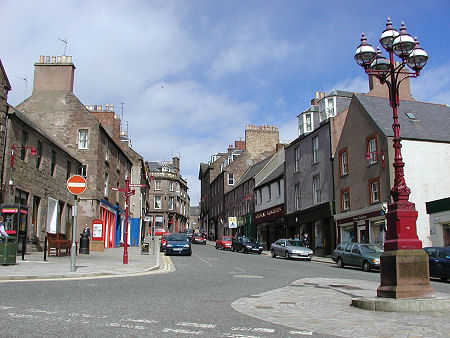 Brechin, Where Robert Watson-Watt was Born |
Sir Robert Alexander Watson-Watt, FRS, FRAeS, lived from 13 April 1892 to 5 December 1973. He is generally regarded to be the "inventor of radar": and while not the first to consider the possibilities in this area, he was the first to produce a workable system that turned the theory into a weapon critical to winning World War Two. The wider picture in Scotland at the time is set out in our Historical Timeline.
Robert Watson-Watt was born in Brechin and was a descendant of James Watt, the engineer and inventor whose improvements to the steam engine were fundamental in bringing about the industrial revolution. After schooling in Brechin he attended the University College, Dundee. Watson-Watt graduated with a BSc in engineering in 1912, and was offered a post working with Professor William Peddie who encouraged him to study wireless telegraphy, the usual name for radio at the time.
In 1915 Watson-Watt joined the Meteorological Office, who were interested in his ideas about using the radio waves given off by lightning to detect and locate thunderstorms. The difficulty in pinpointing the direction of these short-lived signals led him to use rotating directional antennas to find them: and from 1923 Watson-Watt also used oscilloscopes to display the output of the antennas. The operator would rotate the antenna, looking for "spikes" caused by lightning that would then show the direction of the storm.
By 1934, Watson-Watt had been appointed Head of the Radio Research Station at Ditton Park near Slough. He was approached by H.E. Wimperis from the Air Ministry, who asked him whether radio could be used to produce a death ray following German claims they had built such a device capable of destroying towns, cities and people. Watson-Watt said it was virtually impossible, but he also flagged up progress in the use of radio to detect and count aircraft.
On 12 February 1935 Watson-Watt and his assistant Arnold Wilkins sent the Air Ministry a report entitled The Detection of Aircraft by Radio Methods. On 26 February 1935, Watson-Watt and Arnold Wilkins met an observer from the Air Ministry for a practical demonstration. In what has become known as the Daventry Experiment they were successfully able to detect signals from the nearby BBC radio transmitter reflecting off a circling RAF bomber at ranges of up to 8 miles.
Two weeks later Watson-Watt sent Wilkins and a group of colleagues, including Edward George Bowen, to undertake further research at Orfordness: and on 2 April 1935, Watson-Watt was granted a patent for radar. By June the group at Orfordness were detecting aircraft at beyond 15 miles, at which point the Government stopped all work on competing sound-based aircraft detection systems. By the end of 1935 radar detection range had increased to over 60 miles, and plans were in hand to construct five radar stations protecting the eastern approaches to London.
Early tests of what became known as the Chain Home system using live bombers and intercepting fighters were a complete failure. The problem was not with the radar, but with the way in which the information generated was interpreted, and instructions then passed on to the intercepting fighters. Watson-Watt responded by setting up a system in which all reports were sent to a single large room for mapping. Observers in the map room were in direct communication with the intercepting fighters and directed them to the approaching bombers.
By 1937 the first three Chain Home stations were complete, and tests of Watson-Watt's new command and control system had proved it highly effective. An order was immediately placed for 20 more stations. By the outbreak of war, 19 Chain Home stations were operational, with over 50 being built by 1945. The Germans were aware of the construction of the stations, but following a flight of Zeppelin LZ130 designed to sample the signals, they concluded that they were for long range naval communications.
In 1936 it became clear that the Luftwaffe could change to night bombing if fighter interception meant it was unable to complete its missions in daylight. Watson-Watt asked Edward Bowen to develop a radar that was small enough to be carried by a fighter and accurate enough to bring the fighter to within the 300m of a bomber needed for night-time visual location and identification. These radars were operational by 1940, and Bowen also later developed a radar capable of detecting surfaced submarines at long range from the air.
Watson-Watt went to the USA at the end of 1941 to help improve air defences there in the aftermath of Pearl Harbor. He was knighted in 1942, and in 1952 he was awarded £50,000 by the British government for his work on radar. In the 1950s he worked in Canada, then the USA, before returning to Scotland in the 1960s.
In 1966, at the age of 72, Sir Robert Watson-Watt married Dame Kathryn Jane Trefusis-Forbes. Dame Kathryn was 67 at the time, and had also played a significant role in the Battle of Britain as the commander of the Women's Auxiliary Air Force, which supplied the radar-room operators. Thereafter they lived in London in the winter and at Kathryn's home, The Observatory in Pitlochry each summer. Dame Kathryn died in 1971, and Robert Watson-Watt died in 1973 in Inverness, before being buried alongside Kathryn in Pitlochry.
On 3 September 2014 a statue of Robert Watson-Watt was unveiled in his home town of Brechin by HRH the Princess Royal.


